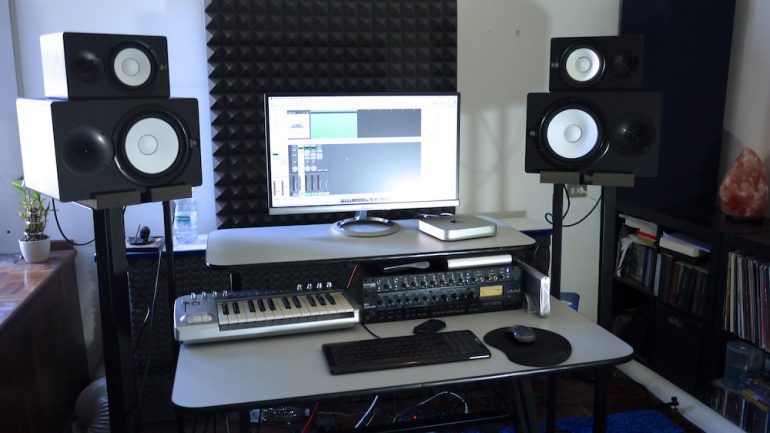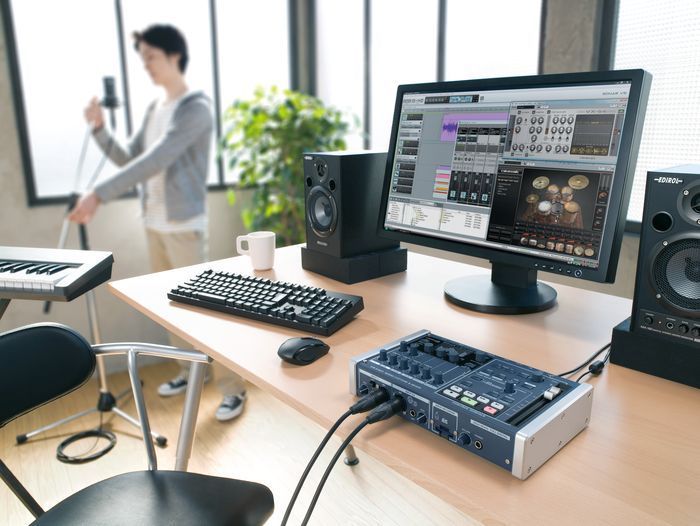
Wouldn’t life be so much easier if you had your own studio at the house? But, the equipment is super duper (hyphy, hyphy) expensive, you say? …. Not. What people tend to forget is that the basics STILL work and can get you started. In this How-To, you’ll learn how to create your own basic studio set up within your budget. Gang!
Step 1: Cop Your D.A.W.
D.A.W. stands for Digital Audio Workspace. Also known as Pro Tools, Logic Pro, Reason, etc. This is what you’ll be using to record/produce on. This might be the only really pricey piece of equipment you’ll buy. Remember that plugins such as Auto-Tune are sold separately.
-Pro Tools offers a free download option, however, you can only record up to 16 audio tracks, 16 instrumental tracks, and there are only 20 plugins included. BUT, compared to the full version of Pro Tools, which is $700, it’s a pretty good deal to get you started on your producer track. If you’re really about it, sell those 16 beats you made and make that $700 real quick to invest in your craft!
-Logic Pro X is another D.A.W. you can learn to produce and audio engineer with. It can be downloaded through Apple and it goes for about $200. Some people take the risk of searching for a free, older version online, but if you go this route just be safe and don’t download a virus. Chances are you’ll be straight.
-Reason is the last D.A.W. we’ll cover in this article. You can produce, as well as engineer, through the software. Although Reason typically runs for about $400 (unless you purchase on Black Friday-Cyber Monday, then it’s $300), they offer thousands of midi sounds and a variety of effects, and its UI is more visually pleasing than all other D.A.W.’s.

Step 2: Pick Your Speakers/Headphones
It’s essential that you have the right equipment to listen to the music you’re making…duh. Speakers are ideal, but headphones are a cheaper option until you’re willing to spend your money on a set of speakers. A good pair of Audio-Technica (this brand is preferred amongst many musicians) will run you about $60-70 dollars. When it comes to speakers, new is always a plus, but from me to you, used speakers can provide the same experience…just make sure they’re in pretty good condition before you buy them (they list the condition on used items on every music equipment site). The brands I’ve listed below and their prices are what you should aim to cop when looking for speakers:
-M-Audio:
-New (pair) – $80
-Used (pair) – $50
-M-Audio has really basic speakers, but they’re the cheapest option until you decide to upgrade. They’ll get the job done for a while. Note: these are not my favorite to mix on due to the sort of muffled sound which is not ideal for mixing, but they will suffice for regular listening.
-KRK Rokit:
-New (pair) – $300+
– Used (pair) – $170-200
-Rokit speakers are used by lots of professionals in the music industry.
-Yamaha HS:
-New (1 monitor) – $150-200
-Used (pair) – $300+
-Yamaha is the preferred brand in the industry, and there’s almost always a pair in every studio.
Step 3: Interface
Although your laptop has a built-in audio interface, it limits your abilities, and it’s not up to par for mixing, recording or producing music. This means an audio interface is needed to provide better quality. Basic interfaces aren’t really that pricey. Usually, if you purchase them through Guitar Center you get a free D.A.W. download included with your purchase. Basic interfaces usually range from $80-150. Here are some good interfaces to look out for when purchasing:
-Focusrite Scarlett Solo
-New – $89
-Used – $39
-M-Audio Fast Track Pro
-New – $100-120
-Used – $40-60
Step 4: Create A Space & Soundproof
You’ll need space to put all of your equipment. You’ll also need a confined space if you plan on recording vocals, such as a closet, or a corner you can block off. You will likely also need to figure out some type of soundproofing. This will help with recording by absorbing the sound instead of the sound just bouncing off the walls. You can make your own makeshift soundproofing by pinning mattress foam, or a comforter to the walls in your closet or corner. You also have the option to purchase soundproofing panels which cost $60+.

Step 5: Buy Studio Accessories/Necessities
You’ll need the following to complete your studio:
-Keyboard
M-Audio sells really good keyboards for the low! Their used keyboards range from $50-80. Their new keyboards aren’t that pricey either, they’ll probably go for about $100-150, and if you buy them through Guitar Center your purchase comes with a free D.A.W.!
-Mic
These are the best budget mics based on my research:
-MXL 990 – $70-100
–Audio-Technica AT2035 – $80-150
-Mic stand
Any basic stand will work and they typically range from $20-25. Guitar Center has a good variety as well as Sweetwater.
-Mic isolation shield
You’ll need this so your vocals aren’t bouncing all over the place. They run for about $60 but it’s common to find used ones for about $40
-Hard drive
You’ll definitely need a hard drive to store all your files on, because if your laptop/computer crashes you’re screwed… Typically 1TB or 2TB are needed since D.A.W. files take up a decent amount of space. 1TB is 1,000 GB, that’s 30 times more than your average iPhone storage!
-LaCie Rugged External Hard Drive Used by a handful of professionals including myself. Typically goes for around $60-90.